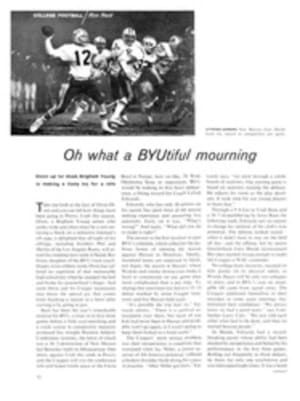
IF IT WON'T SINK THE SHIP, HERE'S A BOAT FOR ONE DEAR TO YOUR HEART
Now that a challenge is in the wind, this might be the moment to begin thinking of a new 12-meter yacht for '77. A long lead time in preparing for an America's Cup defense is a must, say the experts. So is money. But if you start soon, it probably would be possible to get the jump on inflation, which bids fair to put the price of future yachts in a class with aircraft carriers. Otherwise, you might want to shop around for a used model.
Take, for example, Courageous. The total tab for the defender came to $1.3 million. This breaks down into design fees and tank tests of approximately $200,000, building of hull and rig $400,000, winches at $50,000 and an assortment of sails amounting to 565,000. To these heady figures add a half-million for expenses. But let it be immediately emphasized that the donors of the money and those toiling on Courageous were equally dedicated to the defense of the cup: syndicate members received no tax deduction for contributions, nor was any crew member paid.
Thus it has been since 1958, when the rules were changed to permit competition by 12-meter yachts—small by pre-World War II standards, yet now more expensive than bygone monsters setting acres of canvas tended by dozens of professionals. However, this year the first rift appeared in the financial storm clouds threatening future cup matches. Mariner campaigned under the aegis of the U.S. Merchant Marine Academy, while Intrepid represented the Seattle Sailing Foundation, both sanctioned as nonprofit educational institutions by that habitual spoilsport, the Internal Revenue Service. The Australian challenger, Southern Cross, was reputedly deductible in the promotion of a real estate development.
The disastrous performance of Mariner and Southern Cross introduces another problem that must be faced by anyone eager to own a challenger. Naval architecture is not an exact science, alas. A whiz on the drawing board or in the testing tank may turn out to be a dog afloat. The current international 12-meter rule provides no loopholes for the emergence of a superboat; instead, astronomic amounts of money and time are lavished striving for an almost infinitesimal improvement. A designer must call upon every resource of computer technology to achieve perhaps 1/10th of a knot more speed, an edge so slight that two people strolling together with that difference in speed between them could keep within earshot for a long way. Over the 24.3-mile cup course in average wind velocities it amounts to about 800 yards, or three to four minutes in time—as decisive in a match race as sneaking aboard jet propulsion. Unfortunately, there is no way of knowing which boat will possess the fractional advantage until a million or more is spent. Mariner's mode! tank tests indicated that designer Britton Chance Jr. had achieved a phenomenal hull. Her radical chopped-off stern seemed to fool the water into believing it was really a traditional tapered counter, thereby providing a higher speed potential without penalty. The full-size Mariner failed to fool the water or anything else, save perhaps her backers.
Perhaps most discouraging is what happens to winner and loser alike when the last gun has fired. The 1974 crop of cup candidates had become so specialized as to be useless for any other purpose. Thus, if you want to pick up a known quantity for the next defense rather than go through the traumatic experience of building, you might consider Mariner at a bargain-basement price of around 5150,000. Should you prefer to begin at the top with Courageous, undoubtedly the fastest 12-meter yacht in the world, be prepared to dig deeper—a lot deeper, but still a saving over new construction. The recent performance of Intrepid proved that a really top Twelve can remain competitive a long time. Launched in 1967, Intrepid defended that year and again in '70, and only missed this time by an eyelash—or, perhaps more accurately, by a broken backstay in the final trial. The fact that Olin Stephens, acknowledged world master and creator of both Intrepid and Courageous, failed to produce a significantly faster boat in seven years is an added commentary on naval architecture.
Having reached a peak of performance that also marks the end of an era, the New York Yacht Club last month began steps to give Twelves a useful afterlife, hoping to bring down costs through increased resale value, especially for unsuccessful candidates. Syndicate organizer George Hinman avers his Mariner could command at least $300,000 if she could be converted into an ocean racer. So in '77, at the minimum, winches will go back on deck, making it possible to provide accommodations below, cockpits will be made self-draining, and deck hatches waterproof. Present boats will not be made obsolete, but will be more seaworthy after conversion. Later may come masthead rigs, greater freeboard, and a relaxation of the penalty on beam. For the present, a switch to yachts built under the International Offshore Rule, or abandonment of closed-course match racing, is not contemplated. Thus, if the challenge already received from the Royal Corinthian Yacht Club of Cowes is accepted, Twelves will still be Twelves, and now is the time to begin shopping. Anyone for a Christmas stocking present?

